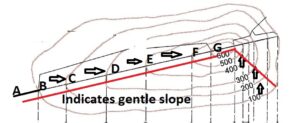Topographic Maps: A Comprehensive Guide For Beginners
Topographic maps are an essential tool for hikers, outdoor enthusiasts, and anyone else navigating through the great outdoors. These maps offer comprehensive details about the topography, altitude, and natural features of a specific area. For beginners, understanding how to read and interpret a topographic map is crucial for a safe and successful adventure.
Understanding how to read contour lines on topographic maps is among the most crucial skills for novices. You can see how steep the terrain is by referring to these lines on the map, which show changes in elevation. It’s also critical to comprehend the map’s scale, as this will help you gauge distance and organize your itinerary.
In addition, being able to identify key features such as rivers, lakes, and natural landmarks will help you navigate more effectively. By familiarizing yourself with these basics, you’ll be well-equipped to use a topographic map to explore and enjoy the great outdoors.
Topographic Maps: A Comprehensive Guide For Beginners
How To Read Topographic Maps?
Topographic maps may look confusing at first glance, but with little understanding, they can be very useful tools.
Below are some useful tips for beginners on how to read topographic maps.
By familiarizing yourself with these basics, you’ll be well on your way to using topographic maps.
Understand the key:

Image Courtesy: Knowledge Boat Modified
Topographic maps use contour lines to represent the elevation of the land.
The closer the contour lines are together, the steeper the terrain. When the distance between the contour lines is less, it indicates a steep slope.
Similarly, if the gap (distance) between the contour lines is more (wider), it indicates a gentle slope.
Learn how to read contour lines:
Contour lines depict the shape of the land, with lines forming circles around hills or valleys.
As given in the diagram, the red line shows the shape of the land.
It has a gentle slope on the west side as the gaps between the contour lines are wider.
On the other hand, the land is steep because the gaps between the contour lines are narrow.
Look for symbols:
Topographic maps also include symbols for things like campsites, trails, and bodies of water.
Understanding these symbols can help you navigate more effectively.
Use the scale:
Pay attention to the scale of the map to understand how distances are represented.
For example, in the given figure suppose 1 cm = 100 m. and the distance between point A and point B is 1.5 cm on the map.
It means the total distance between point A and point B will be 150 m.
Topographic Maps: A Comprehensive Guide For Beginners
Applications of Topographic Maps in Various Fields
Topographic maps are a valuable tool. It provides a wealth of information on the physical features of an area.
These are extremely helpful to a geographer, urban planner, environmental scientist, or outdoor enthusiast.
understanding how to read and interpret these maps can be extremely helpful.
Let’s see what are the top five fields where topographic maps are commonly used:
Geology:
If you are a Geology student, Topographic maps are essential for studying the Earth’s surface and subsurface.
It helps geologists identify the type of landforms such as mountains, valleys, plateaus, plains, and rivers.
Also, it helps in providing valuable insights about the geological history and processes of an area.
Urban Planning:
Topographic maps are also essential to urban planners.
They use it to analyze and plan the development of cities and towns.
The planners understand the natural features of an area, such as slopes and elevation which can impact the design of infrastructure and buildings.
Agriculture:
You will be surprised to know that topographic maps are also helpful to farmers and agricultural researchers.
They use it to plan and manage their land.
These maps provide information on soil types, drainage patterns, and elevation changes.
All these help farmers make informed decisions about crop selection, irrigation, and land use.
Defense Operations:
Topographic maps play a vital role in defense operations.
These maps provide crucial information about the terrain.
Defense people come to know about the elevation, slope gradients, and natural obstacles.
It allows military planners to identify key tactical positions, plan routes for troop movements, and devise defensive strategies.
By analyzing topographic maps, defense forces can anticipate potential enemy movements.
They can also assess the vulnerability of their positions, and determine the best locations for surveillance and communication systems.
Moreover, these maps are essential for mission planning, logistical support, and emergency response operations.
Defense people can navigate complex environments, and allocate resources effectively.
These maps also help in responding swiftly to changing circumstances on the battlefield.
So, if you want to join the Indian Army (NDA), you need to have knowledge of topographic maps.
Outdoor Recreation:
One of the most used topographic maps is for Outdoor enthusiasts.
If you are a hiker, biker, or camper, you will need topographic maps.
These maps will help you to navigate through mountainous and wilderness areas.
Moreover, it will provide valuable information on trails, campsites, and natural features.
With the knowledge of topographic maps, outdoor enthusiasts can safely explore and enjoy their journey.
Topographic Maps: A Comprehensive Guide For Beginners
Technological Advances:
In recent years, topographic mapping has come a long way. Thanks to advances in technology. It is helpful for a beginner looking to learn more about this fascinating field. Also to the professionals interested in the latest developments. Let’s read and learn more about the use of technological advances in topographic mapping:
LiDAR Technology:
Have you heard about LiDAR Technology?
LIDAR stands for Light Detection and Ranging.
This technology uses light pulses to create highly detailed 3D maps of the Earth’s surface.
LIDAR technology is revolutionizing topographic mapping by providing accurate elevation data.
Not only that, it also captures fine-scale features that were previously difficult to map.
Drones:
In recent years, Drones have become an invaluable tool for topographic mapping.
It provides quick and efficient data collection of hard-to-reach or hazardous areas.
With the help of high-resolution cameras and LiDAR sensors, drones can produce detailed maps with minimal human intervention.
Satellite Imagery:
Satellite imagery is among the latest technologies.
Satellites have been used for topographic mapping.
This technology has greatly improved the resolution and accuracy of the data collected.
With the help of Satellites, now we can capture detailed images of the Earth’s surface.
Moreover, it provides valuable information for topographic mapping projects.
Geographic Information Systems (GIS):
With the help of GIS software, today it is possible to analyze, visualize, and interpret topographic data in ways that were previously impossible.
This technology has made it easier to combine various data sources.
It combines LiDAR, satellite imagery, and field surveys, to create comprehensive and detailed topographic maps.
Artificial Intelligence:
In today’s world of technology, AI algorithms are helping us to process and analyze large amounts of topographic data.
With its help, automating tasks can be performed easily that were once time-consuming and labor-intensive.
AI can identify patterns and trends in topographic data, leading to more accurate and efficient mapping results.
In conclusion, technological advances in topographic mapping are transforming the way we collect, analyze, and interpret data about the Earth’s surface. Whether you’re a beginner or an expert in the field, staying up-to-date on the latest developments in technology is essential for producing accurate and detailed topographic maps.
Topographic Maps: A Comprehensive Guide For Beginners
Historical Development of Mapping
Introduction to Topographic Mapping:
As discussed earlier, topographic maps have been used by explorers, adventurers, and cartographers for centuries.
It helps in depicting the physical features of a particular area including mountains, rivers, and roads, in a detailed and accurate manner.
Early Beginnings:
The history of topographic mapping can be traced back to ancient civilizations.
Egyptians, Greeks, and Romans created maps to navigate their surroundings and plan military campaigns.
However, these early maps were rudimentary but laid the foundation for the more advanced mapping techniques that would develop over time.
The Age of Exploration:
Initially, the 15th and 16th centuries saw a surge in topographic mapping.
European explorers set out to discover new lands and chart the world’s geography.
These explorers used a combination of surveying techniques.
They used compasses, and sextants to accurately map coastlines, rivers, and mountain ranges.
Modern Advances:
The Industrial Revolution brought significant advancements in topographic mapping.
This was done with the help of the development of aerial photography, GPS technology, and Geographic Information Systems (GIS).
These tools allowed cartographers to create highly detailed and accurate maps of the earth’s surface, revolutionizing the way we navigate and understand our world.
Future Trends:
The future of topographic mapping looks promising as technology continues to evolve.
With the help of drones, LiDAR technology, and satellite imagery, cartographers are now able to create 3D maps.
Moreover, these maps are not only useful for navigation but also for environmental monitoring, disaster prevention, and urban development.
Topographic Maps: A Comprehensive Guide For Beginners
Creating and Customizing Maps
Are you ready to take your mapping skills to the next level? Creating and customizing topographic maps can be a fun and rewarding process. It allows you to explore the natural world in a whole new way. Whether you’re a seasoned mapmaker or a complete beginner, these five tips will help you get started on your journey to mastering topographic maps:
Understand the basics:
If you want to dive in creating your topographic maps, then it’s important to have a solid understanding of the basics.
These maps use contour lines to represent the elevation and shape of the land.
Familiarize yourself with the key elements, such as scale, legend, and symbols, to ensure you have a solid foundation.
Choose the right tools:
If you want to create topographic maps, do not forget to have the right tools that can make all the difference.
Use mapping software like QGIS or ArcGIS to help you create accurate and detailed maps.
You can also use online tools like Google Earth or the USGS 3D Elevation Program.
Customize your map:
You must also have the ability to customize topographic maps to fit your specific needs and preferences.
Try and experiment with different color, and shading techniques to make your map visually appealing and easy to read.
Moreover, additional layers can also be added for rivers, roads, or landmarks to provide context and enhance the overall map experience.
Consider your audience:
When creating topographic maps, you must keep in mind, who will be using them and tailor your design accordingly.
For hikers or outdoor enthusiasts, focus on highlighting trails and elevation changes.
This will help them to navigate the terrain.
For urban planning or scientific research, include detailed topographic data and annotations to convey complex information accurately.
Practice, practice, practice:
Last but not least, like any skill, creating and customizing topographic maps takes time and practice to master.
Do not hesitate to experiment with different techniques and styles to find what works best for you.
Take the help and inspiration from other topographic maps and create your unique designs to push your creative boundaries.
Finally, with practice, patience, and dedication, you’ll soon be able to create stunning topographic maps that will showcase the beauty and complexity of
the natural world.
Topographic Maps: A Comprehensive Guide For Beginners
Conclusion:
Topographic maps, help you to identify the key features easily. With advancing technology, topographic maps have come a long way. With high-resolution cameras and LiDAR sensors, drones are now helping us to create and analyze topographic maps at the next level. It allows you to explore the natural world in a whole new way. If you are a student of Geography, Geology, or Geophysics, this article will be helpful to understand more about these maps. Do write your views on this article.




0 Comments